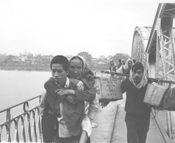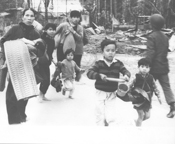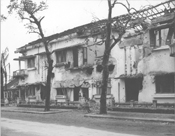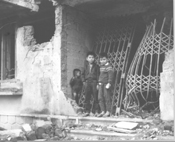- Exhibits
- Tet Offensive
- Hue
- The Attack
The Tet Offensive (Tết Mậu Thân)
- The Tet Offensive (Tết Mậu Thân)
- Hue: The Imperial City
- The Battle of Khe Sanh
- The Battle for Saigon
- Aftermath of the BattlesPolitical ConsequencesExhibit Credits
Hue: The Attack

As South Vietnamese and allied military units drove invading North Vietnamese out of the southern half of Hue during the recent battle for the old imperial capital of Vietnam, thousands of refugees fled from communist-controlled areas of the city....
(Douglas Pike Photograph Collection [va001674])
Civilians run to escape enemy fire during the 26-day battle for Hue Citadel
(Douglas Pike Photograph Collection [va001625])The peace enjoyed by Hue’s inhabitants would not last beyond 31 January 1968, however, as the massive, coordinated attacks of the Tet Offensive commenced throughout South Vietnam. As part of the Vietnamese communists’ plan for a General Offensive-General Uprising throughout the South, PAVN and VC forces carefully planned and conducted an all-out attack on Hue. In the days and weeks prior to the traditional Tet cease-fire, Viet Cong operatives quietly infiltrated the city, establishing networks of communication, secreting weapons caches into and throughout the city, and gathered vital intelligence regarding ARVN strengths, dispositions, and defensive capabilities. While their communist brethren secretly established positions in the city, PAVN units moved slowly into place outside of Hue. Elements of the 4th, 5th, and 6th PAVN regiments moved into position and awaited the signal to begin the offensive against Hue.
Just a few days later, we’re sitting up on the tombstones, looking down, literally, it was fifteen, eighteen hundred feet above Hue and you could easily see into Hue at night. We’re saying, 'You know what? The Vietnamese really know how to celebrate their New Years. Would you look at all the fireworks going off down there? Man, that’s pretty cool.' Boy, the radios started humming and that was the start of Tet.
- Michael Ward [Oral History #OH0301], Transcript page 30 lines 27 – 31.
(complete interview; transcript; more information)The communist plan was an ambitious one. After launching rocket and mortar attacks against the city, the PAVN units entered Hue and in coordination with VC units attacked numerous strategic and tactical objectives. Communist forces assaulted positions south of the Perfume, taking and holding many blocks of the city’s administrative center, essentially stopping any effective governance of the city. Full-scale attacks against ARVN forces in the Citadel were equally effective, driving Gen. Ngo Quang Truong’s 1st ARVN Division back into its headquarters, located in the northern corner of the walled city fortress. Viet Cong units then fanned out into the city, disrupting the local police and causing a general panic amid the chaos. Propagandizing as they went, the communists hoped to foment a general uprising within Hue against the government in Saigon, a call to arms against what they believed to be an illegitimate government that was backed by imperialist American forces.
Don’t send anybody over Hue [flying helicopters]. It’s a hornet’s nest.
- Alfred DeMailo [Oral History # OH0262], Transcript page 26 line 2.
(part 1 of the interview; transcript; more information)By the end of the day of 31 January, Hue was in communist hands. Despite the spirited defense offered by Truong’s overwhelmed 1st Division, as well as by those few Americans and ARVN south of the river, Hue had fallen. This major prize of the Tet Offensive showed to the world the capabilities of Vietnam’s communist forces. The 1st ARVN Division had not been destroyed, however, and was still largely intact. Plus, the communists’ failure to cut the strategically-important Highway One would allow American and ARVN forces to reinforce and resupply the defenders of Hue. In time, these would prove to be decisive factors in the battle for the city, but for the coming month the battle would rage and the flag of the communist National Liberation Front would fly over the Citadel.
Texas Tech University Vietnam Center Sixth Triennial Symposium: Session 5D: The Battle for Hue - March 14, 2008 (76:40 min/sec)
Session 5D The Battle for Hue Moderator: Andrew Wiest, PhD, Associate Professor of History, The University of Southern Mississippi "New Insights into the Battle of Hue, Tet 1968" - Erik B. Villard, PhD, Historian, US Army Center of Military History "The Battle of Hue Through the Eyes of its NVA Battlefield Commander" - Nguyen Ngoc Bich, Independent Researcher
Vietnam Center & Sam Johnson Vietnam Archive
-
Address
Texas Tech University, Box 41041, Lubbock, TX 79409 -
Phone
(806)742-9010 -
Email
vnca@ttu.edu



